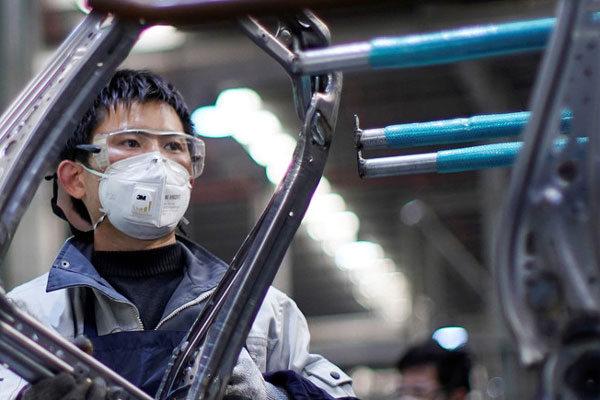
standard wheels:with Andrew Muzamhindo
It’s so easy not to conceptualise what happens before a vehicle is in the showroom or on the road, whether it be a grey import or a new one.
Components for vehicle manufacturing come from all over the world. So do raw materials. China is one of the world leaders in vehicle and components manufacturing. So is Italy, the USA, Germany, Thailand and many more. Car sales in China fell 92% in the first half of February.
The impacts are being felt around the world, as shortages affect production.
Factories have been closed in China as I write. In 2019, Hubei province, of which Wuhan is the capital, was the fourth-largest car producer in China, with about 10% of the country’s car-making capacity and produced 2,24 million vehicles. Coronavirus is said to have originated in Wuhan. That is where it was first identified. Thirty years ago it had less than 40 000 cars.
Wuhan is no ordinary Chinese city. It has good transport links. It has a cheap, well-educated labour force which has been a driving force for its auto industry growth.
Wuhan has a population of 10 million. It has become a transport hub, the car city of China. The automobile industry represents 20% of the city’s economy, with 200 000 direct jobs and more than a million indirectly.
And Wuhan’s car industry is growing fast. General Motors and its Chinese partner, Shanghai Automotive Industry Corporation, have launched a new plant capable of producing 240 000 vehicles annually. Renault had just started assembling cars in Wuhan. With the plants operated by the Dongfeng-PSA Peugeot Citroën joint venture and Honda, among others, the provincial capital will soon have about 10 car factories, producing more than 2m vehicles a year, in an area smaller than Mashonaland. In 2014 Wuhan was the world’s seventh-largest centre of automobile production, with 1,13m vehicles assembled, although Chongqing, which assembled 2,3m vehicles last year, tops the global rankings.
- Chamisa under fire over US$120K donation
- Mavhunga puts DeMbare into Chibuku quarterfinals
- Pension funds bet on Cabora Bassa oilfields
- Councils defy govt fire tender directive
Keep Reading
The Chinese government knew that it had to develop Wuhan because of its historical importance. In the early 20th century the revolt that overthrew the Qing dynasty started there. During the war against Japan the town became a rear base for the authorities, and Mao Zedong liked to swim in the Yangtze River. Its flows past Hubei. To develop the automobile, it was necessary to create everything that gravitated around it. The region is well-connected, thanks in particular to the Yangtze River. For thousands of years, the river has been used for water, irrigation, sanitation, transportation, industry, boundary-marking and war. The prosperous Yangtze River Delta generates as much as 20% of China’s GDP. The Three Gorges Dam on the Yangtze is the largest hydro-electric power station in the world.
Wuhan stands out because Dongfeng is involved in more joint ventures with foreign firms than the other state-owned organisations. China is the world’s biggest car market, and Wuhan, the city at the centre of this outbreak, is known as a “motor city” for being home to auto plants, including General Motors, Honda, Nissan, Peugeot Group and Renault. For Honda alone, Wuhan accounts for about 50% of total production in China.
Dongfeng and Renault have a 50-50 joint venture in Wuhan. The facility is a greenfield plant built in just two years. It has the potential to build 300 000 cars per year that is almost 900 cars per day, a car in two seconds. This puts into perspective amount of cars that could have been produced during shut down from just one factory.
This brief outline highlights the importance of Wuhan to the motoring world. You could be in Zimbabwe having ordered the latest Dongfeng truck, bus or Dongfeng cummins engine, with factories closed it means you have to realign your business plan.
The world has become over reliant on China. Tell me one thing that is not manufactured in China or does not have a Chinese component.
General Motors has warned that corona virus might affect it profits. Honda and others will be affected too.
The auto industry world over is sneezing from impact of Corona Virus on the auto industry. Shortages might kick in from China affecting production around the world.
For example, Hyundai and Kia recently stopped several assembly lines in Korea and Nissan announced it would suspend its auto production in Japan. General Motors suggested that production outages could affect plants in Michigan and Texas, Jaguar Land Rover warned the virus could create problems at its assembly plants in Britain, and Fiat Chrysler Automobiles CEO’s Mike Manley said that production at one of the European plants may be suspended soon.
Online shopping for vehicles has also spiked these days as shoppers avoid show rooms and public places. Vehicle manufacturers such as SAIC-GM-Wuling Automobile (SGMW) announced they will produce masks, which can help prevent the virus infection via respiration. There is a shortage of masks.
Most auto plants in Europe and the United States are running at their normal pace but there is a shortage of certain components.
Toyota has reduced its output to a single shift at its four vehicle plants in China, while all of Hyundai Motor Company’s production facilities in Korea and in China are in operation.
It is a fact that corona virus has affected the global auto industry. It might be apt to say when China coughs the world will catch a cold.











